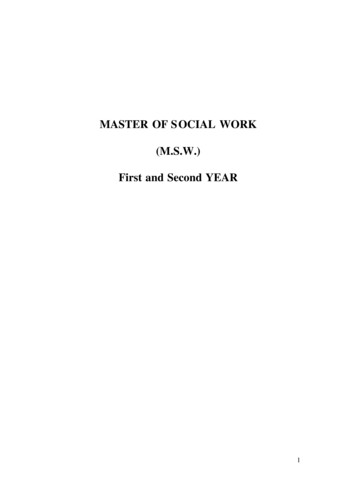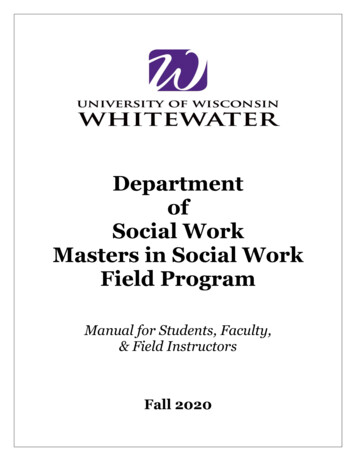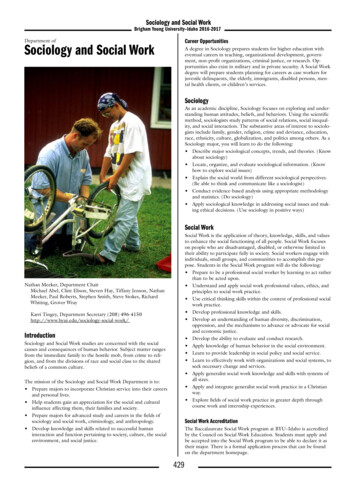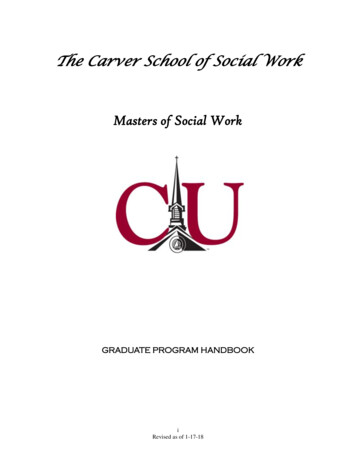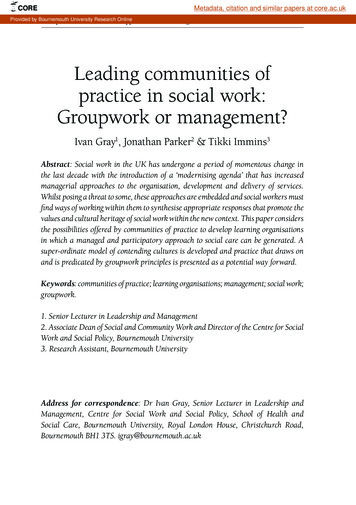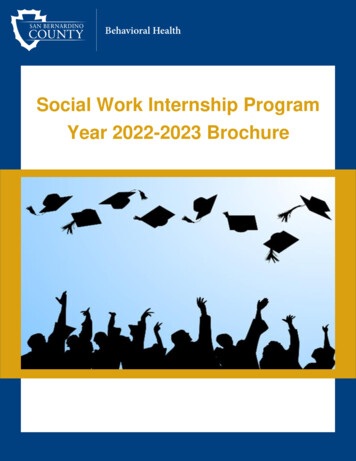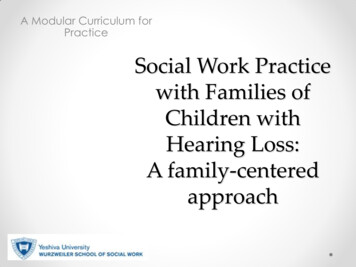
Transcription
A Modular Curriculum forPracticeSocial Work Practicewith Families ofChildren withHearing Loss:A family-centeredapproach
Please cite this module using thefollowing:Newborn Hearing Loss Curriculum AdvisoryCommittee (2014). Social work practice withfamilies of children with hearing loss: A familycentered approach. New York: YeshivaUniversity/Wurzweiler School of Social Work.
Curriculum Advisory Committee:Sarah Jane Dodd, PhD, Silverman School of Social Work,Hunter College, CUNY, NY, NYJeanne Finch, DSW, School of Social Work, Stony BrookUniversity, Stony Brook, NYMary Ann Jones, PhD, Silver School of Social Work, New YorkUniversity, NY, NYSusan Mason, PhD, Wurzweiler School of Social Work, YeshivaUniversity, NY, NYLynn Spivak, PhD, Adelphi University and Hofstra Universities,Long Island, NYBrenda Williams-Gray, DSW, Department of Social Work,Lehman College, CUNY, Bronx, NYWendy Zeitlin, PhD, Wurzweiler School of Social Work, YeshivaUniversity, NY, NY
A family-centered approach to achild’s hearing loss Review: 98% of children in the US are screened for hearing lossshortly after birth in Universal Newborn Hearing Screening programso Slightly more than 1.5% of children do not pass this initial screening Of those children, 8.5% are ultimately diagnosed with a hearing loss,but nearly 40% do not come back for recommendedscreening/diagnosis/intervention These children are lost-to-follow-up or they do not return asrecommended Family-centered practice provides an essential framework forincluding the child and family. Understanding a family-centered approachoooooThe Social worker’s roleThe context and impact of the diagnosisAssessing the child’s and parental responsesAssessing system supportsRecommendations for policy
Topics A family centered approach to hearing lossoooo The social worker’s roleThe context and impact of the diagnosisLoss of hearing and its meaning to the child and familyThe social worker - family relationshipUnderstanding the nature of the child’s hearing losso The importance of early interventiono Tracking the child’s developmental progresso Anticipating implications for educational placement Assessing the child’s and parental responseo The family’s role in facilitating learningo Identifying and remediating challenges System supportso Parent to parent interventionso Group work interventions for children and siblingso Policy implications for practice
A Family-Centered Approach The family unit is the focus of attention The aim is to strengthen the capacity of familiesto function effectively Families are partners in decision making and goalsetting Interventions link families with resources suited totheir needs
Outreach, Advocacy, Education, andCapacity Building The social worker’s role: Outreach, Advocacy,Education, and Capacity buildingo Clinicians need self-awareness and identify potentialbarriers to forming a working alliance with familieso Consideration of cultural factors and family’s resources areessential in order to proceed with each family
The impact of the diagnosis andnature of the hearing losso Loss of hearing and its meaning: exploring myths, stigmasand barriers to service. Here are some examples: Myth: it is not necessary to treat conductive lossesbecause they are transient Stigma: a child wearing hearing aids is likely to bebullied Barrier: cultural norms that are supportive of noncompliance with treatment recommendationso Timing and context: The importance of early intervention toencourage normal language and social developmento Clinicians need to deal with the impact of hearing loss onthe child and family and on the working alliance
Assessing the child’s and parentalresponsesThe social worker needs:o To be sensitive to the family’s response to their child’shearing losso To help families understand their child’s uniqueresponse to hearing losso To support the family’s role in facilitating learningo To identify and make recommendations to remediatechallenges
Assessing System Supports Understanding the family’s context and strengths is animportant task for clinical practice System supports need to be identified: Making early provisions for identifying the child’seducational needs and providing access to earlyintervention Providing access to resources:o Assessing access to available services, including insurance coverageo Parent peer interventions/supporto Group work interventions for children and siblings
Policy ImplicationsThe social worker needs to be aware of policyimplications related to infant hearing loss: Developing the need for advocacy from workingwith individual cases Accessing and developing needed communityresources Making recommendations for change
Case study:A Family-Centered ApproachMr. and Mrs. Hernandez were thrilled with their first-born, alittle girl. Baby Sandra appeared healthy and normal andwas born at full-term. After her birth, the couple was toldthat their baby would be screened for a variety of healthrelated issues, including hearing loss. Both Mr. and Mrs.Hernandez were surprised to hear that their baby had notpassed the hearing screening done in the newborn nurseryin either ear. Nurse Jones assured them that this happensoften, and it does not necessarily mean that Baby Sandra hasa hearing loss. An appointment was scheduled for a followup hearing screening in the couple’s neighborhood. Mr.Hernandez insisted that Baby Sandra be brought to theirpediatrician first in order to get the doctor’s opinion.
Beginning to work with the family You have on your calendar the Hernandez baby, who isscheduled for a re-screen in one week from today. Youhave the information provided on the previous slide. Questions:o What do we know from the literature about families’ willingness to follow-upwith recommended re-screens?o From a family-centered perspective, what strengths emerge in this scenario?o What concerns emerge?o Do the strengths and concerns identified give any clues to your approach toforming an alliance with this family system?
Case study: BabySandra’s re-screenThe pediatrician told the Hernandez’s not to worry aboutthe recommendation for another screening, but that BabySandra should be re-screened. She told them that theneed for a re-screen was fairly common and could becaused by other things besides hearing loss.Mrs. Hernandez called her mother, still concerned aboutBaby Sandra not passing the screening in the hospital.Her mother suggested that she follow the doctor’s adviceand take the baby for her re-screen.Baby Sandra is brought to the hearing and speech centeraffiliated with the birth hospital for the second screening.
Assessing the Family System What additional information has been presented thatadds to your assessment of this family system? What questions are you forming to assess the match ofservices to this family’s needs? How do issues of culture and socio-economic statusaffect your understanding of this family?
Case study: Baby Sandra’sscreeningsBaby Sandra passes her second screening in her rightear, but still does not pass in her left ear.Social Worker Sally, along with the audiologist, ClinicianCraig, inform Mr. and Mrs. Hernandez that Baby Sandraneeds to come back for an diagnostic assessment, whichincludes more in-depth hearing testing to determine whySandra did not pass the screening in her left ear.Mrs. Hernandez asks what this means and wants to knowif Baby Sandra will need a hearing aid.
Case study: The role of socialworkSocial Worker Sally must respond to Mrs. Hernandez’squestion: How would you respond? Why was this response chosen? What issues were youaddressing in choosing this response? Knowing that many children who do not pass theirsecond screening do not come back for additionaldiagnosis or treatment, what would you do to encouragethe Hernandez’s to bring Baby Sandra back to thehearing and speech center? How would you begin to assess whether the servicesoffered are appropriate for this family’s needs andexpectations?
Case study: Baby SandraBaby Sandra is brought back for the diagnostic testing inher left ear. After the testing is complete, Mr. and Mrs.Hernandez are informed that Baby Sandra has amoderate loss in her left ear only. At the end of theirappointment, Mr. and Mrs. Hernandez are told by theaudiologist that a hearing aid is recommended.Mr. and Mrs. Hernandez have a dilemma: they want thebest for Baby Sandra, but they are concerned aboutpossible stigma – bullying, teasing, and looking differentfrom other children – if Baby Sandra gets a hearing aid.
Case study: The role of the socialworkerSocial Worker Sally also has a dilemma: if she pushes toohard for the Hernandez’s to follow-up with therecommendation to fit Sandra with a hearing aid, she maylose them altogether. If she does not strongly encouragethem to get Baby Sandra fitted, she is risking possiblelong-term deficits for the baby, including learning, social,and cognitive challenges.What factors – ethical, social, clinical - exist that aid youranalysis of how best to respond?How would you advise Social Worker Sally? Explain yourreasons for this choice of response.
Case study: Baby SandraThe Hernandez’s can not figure out whether to get BabySandra a hearing aid. At six months old, she seems to bedeveloping normally. She is sitting up, making somesounds and turns her head in response to noises.At her six month check-up, the pediatrician asks what theHernandez’s are planning to do about therecommendation to get Baby Sandra a hearing aid. Mr.Hernandez tells the doctor that since Baby Sandra seemsto be developing normally, they have decided to not getthe hearing aid at this time.
Case study: Social worker roleSocial Worker Sally notices that Baby Sandra has notreturned to the hearing and speech center: What are the chances that, without intervention,Baby Sandra will continue to develop normally? What does the literature tell us about theconnection between stigma and hearing aids inchildren? What would you advise Social Worker Sally to do atthis point? How does viewing the roles of advocate,educator and capacity builder aid your response? What recommendations for service improvementsemerge from your considerations?
Suggested Assignment Utilizing family-centered practice principles design a program forfamilies like the Hernandez’s.o Provide your rationale and identify how this program addresses theconcerns identified in your consideration of this case.o Your program design should include both structural and more directclinical components.o Your program design should be linked to your understanding of both thestrengths and challenges facing this family and others like them. Research whether such programs exist. If found, provide examples ofhow this resource might have responded to the Hernandez family andwhy. If not found, provide an analysis of why you believe this resourceis lacking. Substantiate your reasons.
References and A parent's guide to hearing: ent Interview Progress Report: Communication Development MonitoringProcess for Young Children with Hearing ringCenters for Disease Control and Prevention (2011). A Parent’s Guide toGenetics and Hearing Loss. Available online at ls/ParentsGuide508.pdfThe March of Dimes (2011). Hearing Impairment. Available online at:http://www.marchofdimes.com/baby/birthdefects hearing.htmlMedline Plus (2011). Hearing Problems in Children. Available online msinchildren.htmlNational Institute On Deafness and Other Communication Disorders (2011).Communication Considerations for Parents of Deaf and Hard-of-HearingChildren. Available online mmopt.aspx
References and det.edu/calendar/?step defaultplay&f ParentsPanelCopy FLV 16x9.flv&p ronpaneldiscussions2008&wide trueCortiella, C. (2006). NCLB and IDEA: What Parents Need to Know and Do, MN:National Center on Educational OutcomesDe Fatima Campos, M., Fernandes, C., Marconi Pinherio Lima, M., Diberio deFreitas Rossi, T. (2012). Improvement of return rates in a neonatal hearingscreening program. Social Work in Health Care, 44, 3, 179-190.Fitzpatrick, E., Angus. D., Durieux-Smith, A., Graham, I.D., & Coye, D. (2008)Parents' needs following identification of childhood hearing loss. AmericanJournal of Audiology, 17, 38–49.Samuels, J.,Schudrich, W.,& Altschul, D. (2009) Toolkit for modifying evidencebased practices to increase cultural competence. Orangeburg, NY: ResearchFoundation for Mental Health, pp 18-21Stuart, A., Moretz, M. Yang, E.Y. (2000) An investigation of maternal stress afterneonatal hearing screening. American Journal of Audiology, 9, 2, 135Webb, N.B., (2011). Social Work Practice with Children (3rd Ed). New York:Guildford Press, pp 121-133.Young, A., Tattersall, H., McCracken, W., Bamford, J. The impact of universalnewborn hearing screening: Education perceiving the role of socialservices. Qualitative Social Work, 3, 4, 367-387.
Lehman College, CUNY, Bronx, NY Wendy Zeitlin, PhD, Wurzweiler School of Social Work, Yeshiva . 98% of children in the US are screened for hearing loss shortly after birth in Universal Newborn Hearing Screening programs o Slightly more than 1.5% of children do not pass this initial screening Of those children, 8.5% are ultimately .
